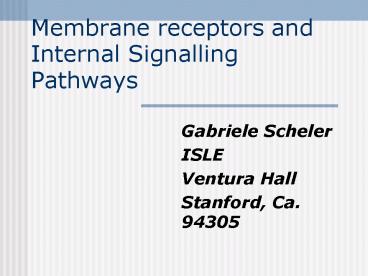Membrane receptors and Internal Signalling Pathways PowerPoint PPT Presentation
1 / 17
Title: Membrane receptors and Internal Signalling Pathways
1
Membrane receptors and Internal Signalling
Pathways
- Gabriele Scheler
- ISLE
- Ventura Hall
- Stanford, Ca. 94305
2
Mitogen-activated Protein Kinase and Protein
Kinase C
growth factor stimulates the system by receptor
activation the system consists of a positive
feedback cycle PKC/MAPK concentration of MAPK
phosphatase (MPK) acts as a regulator for the
system
receptor
3
MAPK /PKC Interaction Two alternative views
Bhalla2003
BhallaRamIyengar2002
Two ways of analyzing the MAPK/PKC signal
interaction
4
Circuit Analysis of MAPK Pathway
5
Circuit Analysis of MAPK Pathway (Alternative)
6
Meaning of Signals
7
Positive feedback makes brief signals last
At a low concentration of MKP (phosphatase),
brief stimuli result in sustained MAP kinase
activation
Simulation
Experiment
BhallaRamIyengar, 1D
BhallaRamIyengar, 1B
Stable state is experimentally confirmed, rise
time could not be reproduced because of
experimental limitations
8
Switching off a step in the pathway
( solid line)
( solid line )
9
Strong negative regulator introduces proportional
response
At a high concentration of MKP (phosphatase),
MAP kinase response is proportional to receptor
stimulation
10
Regulator on feedback cycle induces bistability
(simulation)
Bistable switch
Proportional response
High phosphatase activity
Low phosphatase activity
11
Regulator on feedback cycle induces bistability
Type of MAP kinase response depends on
activity of phosphatase regulator
- signal prolongation (stereotypic response to
trigger stimulus) - signal response proportional
to stimulus input
Alternative analysis - at low levels of
phosphatase sigmoidal shape with steep
rise - at high levels of phosphatase
rightward shift with less sharp rise time
12
Phase Diagram
MAPK vs. MKP level
Low MKP level (left) Kinase is stable at high
levels Intermediate MKP levels (straight line)
unstable fixed points High MK Plevel
(right) MAPK is stable at low levels
13
MAPK and PLA2 Bistability
1 low stable point 2 threshold value 3 high
stable point
Bhalla2003, BhallaRamIyengar2002, 1 C
14
MAPK activation dependent on MKP rate of synthesis
MKP synthesis rate low
Intermediate rate
MKP synthesis rate high
Characteristic time delays produce oscillatory
behavior at intermediate phosphatase synthesis
rates
MAPK activation in response to a brief stimulus
(5 min) over extended time depends on MKP
synthesis rate
BhallaRamIyengar2002
15
PKA and GRK in D1 Receptor Desensitization
dopamine stimulates the system by receptor
activation the system consists of a positive
feedback cycle calcium-inhibits GRK- enhances
receptor efficacy there is also a negative
feedback cycle cAMP activates PKA reduced
receptor efficacy the positive feedback cycle
is limited by high calcium, which activates PKC
16
PKA and GRK in D1 Receptor Desensitization
17
Results of Numeric Simulations
Prolonged activation by calcium signals (state
onset)
Termination of activation by phase delay of PKA
activity (state offset)

